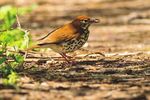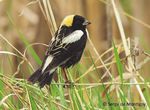Appalachian Corridor NewsNews - Corridor appalachien
←
→
Page content transcription
If your browser does not render page correctly, please read the page content below
Appalachian Corridor
News
Spring 2016 Follow us on
Available online : appalachiancorridor.ca
Preserving habitats around the Parc national du Mont-Orford
By André Champoux, Conservation Consultant
During this past winter, Appalachian Corridor, in partnership with Sépaq (Société des établissements de plein air du Québec), has put in place
a project to protect the periphery of the Parc national du Mont-Orford. The goal is to make landowners in this area more aware of the impor-
tance of preserving lands with important ecological values because, among other reasons, they are located close to a huge protected area.
Biodiversity does not know administrative boundaries created and imposed by humans. Mammals move in and around the park, birds fly over
it and nest there, and plants flourish in the whole region.
It is important to slow the increasing development in areas around the park to minimize land uses that could work against the mission of pro-
vincial parks: to preserve our natural and cultural heritage in these parks. To do this, it is important to permanently maintain and perpetuate
the habitats essential to animal and plant populations, and also to make sure that species are not confined within the park. Under this project,
a peripheral zone was delineated so that organizations and landowners of large properties (more than 5 ha) could participate in the conserva-
tion of natural habitats. The municipalities and the RCMs will also take part in the project. They will take into account the periphery in their
land use planning tools for the region.
WHAT IS A "PERIPHERAL ZONE"?
This is the zone within which legal activities could have a major impact on conservation in the park, on its biodiversity, its environment and
the visitor experience, and inversely, within which the presence of the park has a positive influence on the community that lives there, from
an environmental, social and economic development perspective.
NATURE PROTECTED FOREVER
Appalachian Corridor works closely with landowners and partners to conclude conservation projects. We thank owners and financial partners (p. 4) for their
precious involvement in the creation of new protected areas.
A first property for the Société de conservation du Mont-Brome
The Société de conservation du Mont-Brome has wasted no time in registering its first success story - it has already received its first eco-gift:
the 16-ha Philibert property located in a major forest block of more than 5,000 ha on the southeastern slope of Mount Brome. Conserving this
parcel of land will assure the preservation of high quality habitats (including part of an Exceptional Forest Ecosystem), home to several species
at risk, such as Northern Dusky Salamander, Maidenhair Fern, and
many plant species representative of the natural region, such as
Roundleaf Violet, Red Trillium and Heartleaf Foamflower. The Philibert
property is also habitat for the Eastern Wood Pewee and Wood
Thrush, birds migrating to the forests of our region to reproduce. The
marked decline in their populations in recent years has earned them
the unfortunate distinction of being listed as Species at Risk in Canada.
By making this generous donation, Mr. Philibert hopes to make the
human population aware of the geographic and environmental value
of the lands and landscapes of Bromont. "The preservation of my land
beyond my lifetime is reassuring to me. It is clear to me that we are
not the owners of natural areas; we owe them to future generations".
He also approved of the process that led to the successful completion
From left to right : Marie-José Auclair, President of the Board at Appalachian Corridor;
of his gift: "I was lucky to be assisted by the people from Appalachian Louis Villeneuve, Bromont Councillor; Martin Philibert, Donor;
Corridor and the Société de conservation du Mont-Brome. We share Réal Brunelle, Deputy Mayor of Bromont; Michel Matteau, Chair at SCMB;
Pierre Distilio, Bromont Councillor.
the same vision and I valued their expertise very much. Their dedica-
tion to this cause is unwavering."NATURE PROTECTED FOREVER
15 hectares protected in perpetuity in Bolton-Est: Thanks you Mr. Labonville and Ms. Leclerc!
Conservation des vallons de la Serpentine (CVS) recently protected in per-
petuity the property belonging to Mr. Réjean Labonville and Ms. Gertrude
Leclerc. This brings to more than 12,600 hectares the area of protected
land in the region under the umbrella of Appalachian Corridor and to 224
hectares in the CVS sector. Réjean Labonville explains the reasons behind
their decision to make this gift: "Since we purchased our property in 1982,
we have come to discover the richness and special ecological importance
of the wetland that covers part of our land. This led us to our decision to
protect and preserve this environment forever. It is our small contribution
to a collective effort to leave a clean and healthy environment for future
generations." Françoise Bricault, secretary-treasurer of CVS, wanted to pay
tribute to the exceptional commitment of Mr. Labonville throughout the
process. "He was really involved at every step. He even became a member
of the Board of Directors of CVS."
Martine Ruel, acting Executive Director at Appalachian Corridor added:
"Appalachian Corridor offers its warmest thanks to CVS, and especially to
Mr. Labonville and Ms. Leclerc, for this ecological gift. Their gesture is even Front :
Gertrude Leclerc and Réjean Labonville (owners)
more important since the property is located in a highly valued area at the Back :
heart of the Appalachians." Françoise Bricault noted that "the addition of Françoise Bricault (CVS), Sylvain Lavallée (Notary), Martine Ruel (Appalachian Corridor)
this mostly forested property to a core that already includes six other pro-
tected properties, contributes to consolidating an important corridor in a strategic sector."Many mammal species – especially
White-Tailed Deer, but also Black Bear, Moose, Fisher, Beaver, Mink, Red Fox, River Otter and Coyote – have been observed
here. Moreover, several watercourses cross the Leclerc-Labonville property, providing prime habitats for stream-swelling sala-
manders. Finally, Ovenbird, Black-Throated Blue Warbler, Scarlet Tanager and Hermit Thrush as well as other migratory birds
that seek deciduous forests have been identified here.
CORRIDOR NEWS
A New Guide for Land Use Planning in Harmony with Nature
Appalachian Corridor released Cohabiter avec la nature!, a guide for town and rural land use planners and
local communities in the Southern Appalachians of Quebec. This booklet is intended to facilitate a better
regional planning in a way that also protects nature. While this territory includes public and privately protec-
ted lands, certain natural habitats currently unprotected are essential for the survival of many animal and
plant species. By distributing this guide to all the municipalities in the region, Appalachian Corridor wants to
make local communities aware of the importance of considering nature and landscapes as part of an innova-
tive planning process based on sustainable development precepts. The guide Cohabiter avec la nature! is an
adaptation of a publication titled Make Room for Wildlife published by the Wildlife Conservation Society,
Adirondack Program (with original illustrations by Jason W. Smith). Martine Ruel, Acting Executive Director
at Appalachian Corridor, explains: "The original version caught our attention. It focuses specifically and ef-
fectively on the concept of "fragmentation", while proposing practical solutions to prevent such fragmenta-
tion. Municipalities and real estate developers must be aware of the critical issues at stake, and this guide
answers their questions. We are very pleased with this adaptation and translation for the Quebec context.
Our thanks to the Wildlife Conservation Society for this fruitful collaboration."
To download the guide, go to the Publications section on our website: corridorappalachien.ca
An English version of Appalachian Corridor’s adaptation is also available.
Appalachian Corridor shines at the Gala des prix d’excellence en environnement
des Cantons-de-l’est
Last winter, Appalachian Corridor received a prize in the "Environmental and not-for-profit group" category, in recognition of its efforts to
protect biodiversity and natural environments in the Appalachians, and more specifically, the work of our organization in identifying and put-
ting in place protection measures for the region’s ecological network. Moreover, the late Terri Monahan, cofounder of the organization, recei-
ved a posthumous award in the "Personal contribution" category.
A new member joins the team: a Conservation Advisor
André Champoux guides property owners through the various steps leading to the protection of their land. Before joining
Appalachian Corridor, André worked for more than 27 years for Environment Canada. Before that, he was a researcher at
the Institut national de recherche en hydrologie. He then occupied various management positions where he dealt with
major issues such as the St.-Lawrence River Action Plan, international environmental cooperation, data management and
knowledge, and finally the Musée de la Biosphère in Montreal. He is also the co-author of the book Éléments d’hydrologie.
Welcome, André!CORRIDOR NEWS
Thanks to our volunteers
Over the past year, we were lucky to count on the assistance of volunteers, aged 7 to 77, who made a great
contribution to the mission of Appalachian Corridor.
Our special thanks to Maude Sirois, Jennifer Vallières, Louise Beaudoin, Claudette Marchand, Aline Larocque,
Guylaine Robert, Claire Caron, Scott Cameron, Patrice Pineault, Louis-Frédéric Pelletier, Christina Davidson
Richards and Flavie Boyer who gave generously of their time to help us better protect and manage natural
areas.
PROTECT NATURE’S ASSETS
Your money is protecting nature: a first investment from our
major fundraising campaign
Thanks to the support of Appalachian Corridor and other donors, Nature Conservancy
Canada (NCC) undertook to acquire more than 3 km2 of land in the Montagnes-Vertes
Nature Reserve, Sutton sector. Adjacent to the Mont Sutton ski resort, this property is
the starting point for hikers to access the Montagnes-Vertes Nature Reserve. NCC has
begun a fundraising campaign with its partners to complete the financing for this
acquisition. Contribute online at www.conservationdelanature.ca/sutton or by calling
NCC at 1 877 876-5444, ext. 294, and mention the Sutton project.
Réserve naturelle des Montagnes-Vertes, Sutton sector
5 reasons to love and protect our forests
Number 5: Forests are part of the much-loved landscape matrix of the region. They generate ecotourism − an
important driver for our regional economy − jobs, wood products and even the heat in our fireplaces. Healthy
forests are central to the economy of the Eastern Townships.
Number 4: Forests help in the fight against climate change. They absorb and store carbon in addition to supply-
ing the oxygen we breathe. Big forest tracts are essential for communities to adapt to climate change.
Number 3: Forests contribute to maintaining water quality of springs, streams and rivers, invaluable as drinking
and bathing water. Clean watercourses are bordered by healthy forests that slow runoff, prevent erosion and
maintain a low rate of sedimentation. The roots help preserve intact soils.
Jackson Brook
Number 2: Forests offer habitats and natural corridors for wildlife.
The forest cover, for instance, provides shade and cool temperatures that are essential to certain spe-
cies of salamanders. Moreover, interior forest birds, particularly the Scarlet Tanager, Barred Owl,
Wood Thrush, Pileated Woodpecker, Winter Wren, Blackburnian Warbler and Black-and-White War-
bler all need unfragmented blocks of forests to survive.
Wood Thrush
Number 1: Forests keep us healthy. Science has shown what nature lovers
have known for a long time. Walking in the forest helps reduce stress, improve our mood and reconnect us
with our roots. When we get out into nature, we can stock up on Vitamin D, which is essential for the absorp-
tion of calcium and the prevention of rickets, osteoporosis and mental health problems. Recent studies also
show that regular contacts with nature have a beneficial effect on blood pressure levels and the immune sys-
tem, help to lessen the effects of disease and reduce stress. All good reasons for going out for a walk in the
woods with those we love!
To walk the trails of the Montagnes-Vertes Nature Reserve (Exit 106 off autoroute 10) check the web- Children from
site: www.rnmv.ca Potton’s Day Camp
To learn more about the Appalachian forests and biodiversity in Southern Quebec, please visit our
website: www.corridorappalachien.caHONOURING AN AFFILIATE MEMBER: SCMB
The Société de conservation du Mont Brome becomes our 17th affiliate
A new organization with an ecological purpose has been officially launched in the Bromont
area. The mission of the Société de conservation du Mont Brome (SCMB) is to protect the natu-
ral areas of the Mount Brome massif and its watershed. The SCMB becomes Appalachian Corri-
dor’s 17th affiliate.
Their main goals are to protect in perpetuity the natural areas and landscapes of the Mount Brome massif and its periphery for
the benefit of nature and local communities. Fostering the importance of aesthetic and ecological protection of landscapes and
the sustainable use of natural areas and landscapes are priorities for the SCMB. It is important to note that, since it has received
its accreditation as a charitable organization in 2015, the group may receive and administer donations, testamentary legacies and
other contributions. Environment Canada has granted the group the required status to receive ecological gifts. Please consult the
SCMB website at: www.societeconservationmontbrome.org
Extract from the original article by Lily Gaudreault, published in ICI MAINTENANT, Feb., 2016.
FOCUS ON A SPECIES AT RISK: the Bobolink
Description
The Bobolink is an average-sized passerine or songbird. The males display black underparts and white to pale yellow shoulders
and lower back. The plumage of females is pale-beige, edged with chestnut and, as such, may be confused with certain species of
sparrows. The melodious Bobolink’s song is characteristic: a long, rising warble like a gurgle during the day with various serena-
des of rolled, sharp and sometimes metallic notes.
Habitat and population
The Bobolink lives in fields and agricultural zones of Canada, from British
Columbia to the East Coast. Its population suffered a significant decline sin-
ce the 1970s. In 2010, the Bobolink was listed as a Threatened species by the
Committee on the Status of Endangered Wildlife in Canada (COSEWIC). The
88% decline suffered by the Bobolink population over the past 40 years is
mostly due to habitat loss: There are fewer and fewer hay fields where they
can nest because of changes in agricultural practices.
How can you help?
If you own of a fallow meadow or a hayfield, it is important to protect this
milieu; an essential habitat for the Bobolink and other species such as the
Eastern Bluebird. As the Bobolink nests right on the ground in thick vegeta-
tion, eggs and young are threatened by early cutting. When a field is cut before the young can fly, they have little chance of survi-
val. The ideal is to postpone the first cut after the young have flown away, (i.e. mid-July). Raising the height of the blade between
10 and 12 cm (4-4.5 inches) above the ground can also help to avoid causing harm to the nests and the young.
We were there
Saturday, May 21: As part of David Suzuki’s Nature Open House, Appalachian Corridor and the Parc d’environnement na-
turel de Sutton (PENS) organized a nature rally for the whole family on the village-mountain trail in Sutton. A great way for
everyone to discover Appalachian species.
Appalachian Corridor is a non-profit organization with a mission to protect Appalachian Corridor would like to thank the following partners for their
natural habitats and the biodiversity of southern Quebec Appalachians, in support: The Government of Canada through the Habitat Stewardship Pro-
collaboration with private landowners, local conservation groups as well as
gram for Species at Risk, Canada's National Conservation Plan and Canada
regional, national and international partners.
Summer Jobs; Open Space Conservancy Inc. (an affiliate of the Open Space
Appalachian Corridor, 37 des Pins Sud Institute); the Fondation de la faune du Québec, Echo Foundation; the
Eastman (QC) J0E 1P0
ministère des Transports du Québec; the US Fish & Wildlife Service
Tel: 450 297-1145 • Email: info@corridorappalachien.ca
ISSN 1708-1645 • Legal registration: Library & Archives Canada and Biblio- (NMBCA); Mont-Orford National Park through the Fonds Parcs Québec; The
thèque et Archives nationales Québec Plan d’action sur les changements climatiques 2013-2020; The Ecological
Gifts Program Land Acquisition Support Fund; the Mountain Equipment Co-
Visit our website at appalachiancorridor.ca Operative (MEC); the National Trails Coalition; the towns of Granby and
Bromont and the municipalities of Austin and Eastman (Green Fund).You can also read



























































